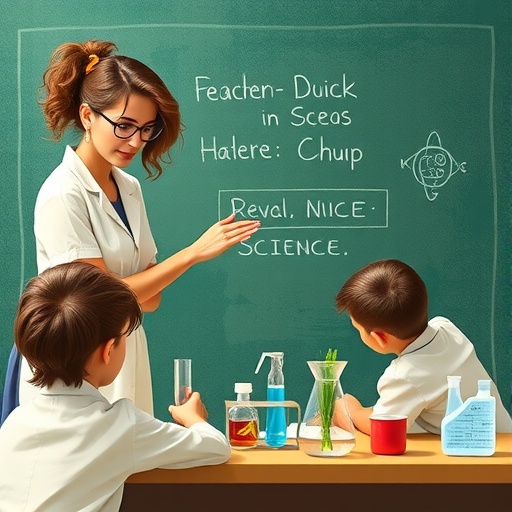In a rapidly evolving educational landscape, the need for effective instructional strategies in the classroom is more urgent than ever. This is especially true in the field of science education, where complex concepts and diverse learning needs abound. The quest to strike a balance between teacher-led instruction and student-led exploration has gained significant attention. Notably, a pioneering study conducted by Cairns elucidates the role of cognitive load theory in this dynamic, showcasing how educators can optimize learning experiences for students through thoughtful pedagogical approaches.
At the heart of Cairns’s investigation lies the intricate interplay between teacher-led and student-led learning. Teacher-led learning has traditionally been the cornerstone of classroom instruction, characterized by direct instruction, structured lessons, and explicit guidance. This method is often deemed effective for imparting essential knowledge, yet it tends to limit opportunities for students to engage actively with the material. This is where the concept of student-led learning rises to the occasion, encouraging autonomy, critical thinking, and deep engagement in the learning process.
However, Cairns highlights a critical caveat—cognitive load. Cognitive load refers to the mental effort required to process information and learn new concepts. An essential takeaway from this research is that both teaching styles can impose varying degrees of cognitive load on students. Teacher-led instruction can alleviate cognitive overload by providing clarity and focused content delivery. On the other hand, student-led learning, while promoting independence, risks overwhelming students if not carefully structured. Striking a balance between the two is paramount to maximize learning outcomes.
The implications of this research extend beyond theoretical frameworks; they resonate deeply within practical classroom settings. For instance, educators are encouraged to implement strategies that scaffold learners during teacher-led sessions while gradually transitioning them to independent inquiry. Such an approach ensures that students are well-equipped to tackle challenging scientific concepts without succumbing to cognitive overload.
Cognitive load theory serves as a guiding principle in this balancing act. It categorizes three types of cognitive load: intrinsic, extraneous, and germane. Intrinsic cognitive load pertains to the inherent difficulty of the material being taught, while extraneous cognitive load arises from poorly designed instructional methods that do not facilitate learning. Germane cognitive load, conversely, involves the mental effort dedicated to processing new information and integrating it with existing knowledge. By understanding these distinctions, educators can better design their lessons to promote effective cognitive engagement.
The study also emphasizes the importance of context in determining the optimal blend of instructional strategies. Environmental factors, student demographics, and existing knowledge frameworks all contribute to how learners engage with content. For example, younger students or those with less foundational knowledge may benefit more from structured guidance, while older or more experienced learners might thrive in a student-led environment that fosters exploration and inquiry.
Furthermore, Cairns advocates for continuous assessment of student understanding as a means to adapt instructional methods on the fly. Real-time feedback mechanisms can inform educators about the efficacy of their teaching strategies, allowing them to pivot as necessary. This iterative process of assessment and adjustment not only enhances learning but also empowers students by making them active participants in their educational journey.
As educators navigate these methodologies, collaboration among colleagues becomes essential. Sharing best practices, co-creating lesson plans, and facilitating peer observations can foster an environment of professional growth. The synergy arising from collaborative efforts can extend the reach of effective instructional strategies, benefiting not just individual classrooms but entire educational communities.
Cairns’s findings resonate with current educational trends that prioritize student agency and engagement. The evolution of classrooms from mere repositories of knowledge to dynamic learning ecosystems reflects a paradigm shift that embraces the holistic development of learners. By integrating both teacher-led and student-led approaches, educators can nurture critical thinking skills, creativity, and a profound understanding of scientific principles.
In the broader context of educational reform, the research also speaks to the necessity for systemic changes that support innovative teaching practices. Policymakers and educational leaders must prioritize professional development opportunities that equip teachers with the skills and knowledge to implement these balanced strategies effectively. Such initiatives can facilitate the cultivation of an educational environment that is responsive to the diverse needs of contemporary learners.
In conclusion, the work of Cairns serves as a clarion call for educators to reflect on their pedagogical practices and the profound impact of cognitive load on student learning. The delicate balance between teacher-led instruction and student-led exploration is not merely a theoretical concept; it is a practical necessity for effective science education. By leveraging cognitive load theory as a guiding framework, educators can foster environments that empower students to take charge of their learning while ensuring they are supported throughout the process.
As institutions and educators heed this call to action, the future of science education holds the promise of inspiring curiosity, fostering innovation, and shaping the next generation of thinkers and problem-solvers.
Subject of Research: Balancing teacher-led and student-led learning in science education
Article Title: Balancing teacher-led and student-led learning in science: the importance of cognitive load.
Article References:
Cairns, D. Balancing teacher-led and student-led learning in science: the importance of cognitive load.
Large-scale Assess Educ 13, 27 (2025). https://doi.org/10.1186/s40536-025-00263-w
Image Credits: AI Generated
DOI:
Keywords: cognitive load, teacher-led learning, student-led learning, science education, pedagogical strategies, educational reform




